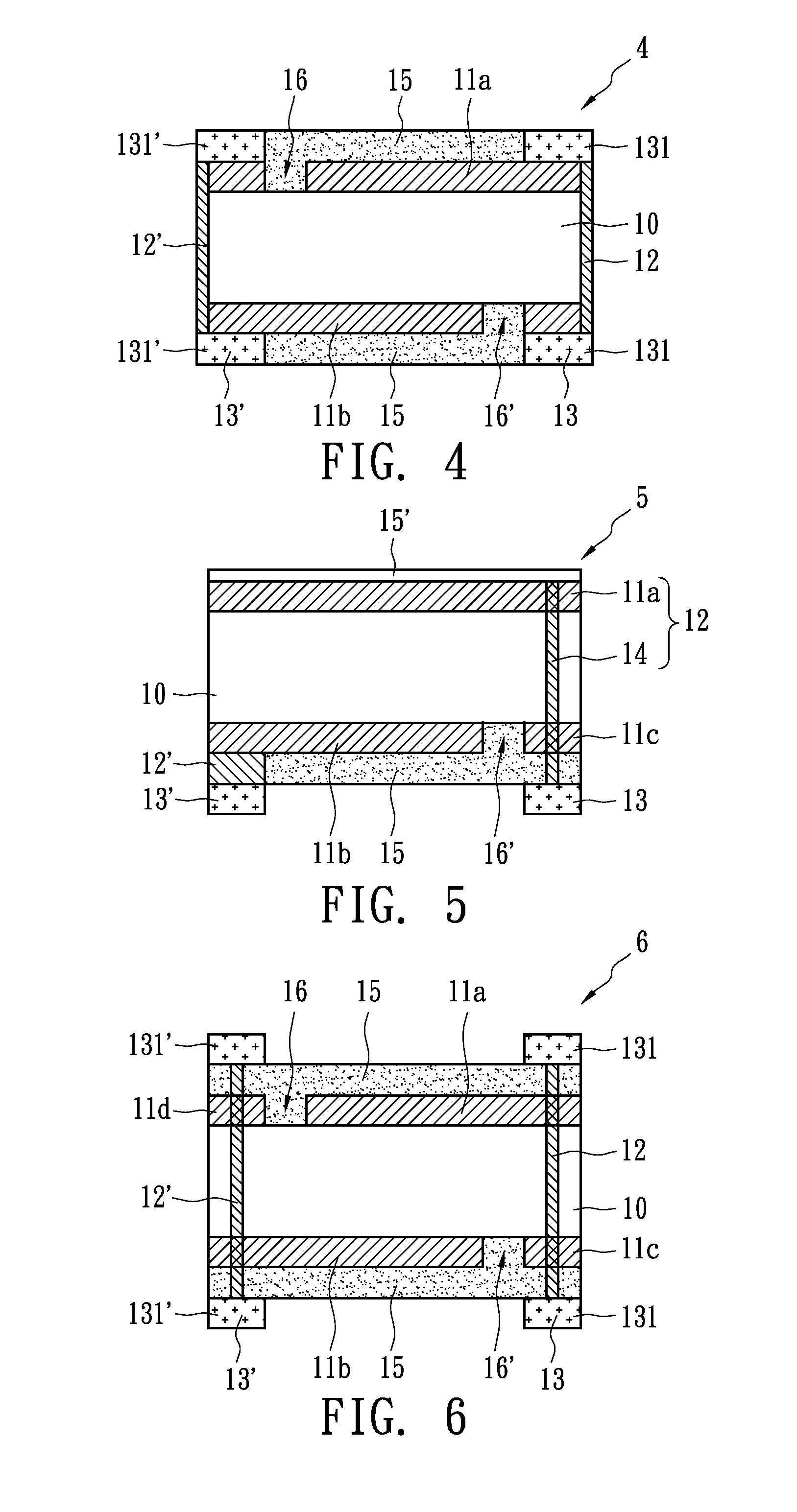Surface mountable over-current protection device
a protection device and surface mount technology, applied in the direction of resistor details, resistors, positive temperature coefficient thermistors, etc., can solve the problems of reducing the performance reducing the efficiency of smd over-current protection devices, and often losing the characteristic of voltage endurance of ptc conductive composites, etc., to achieve the effect of effectively dissipating the heat generated by the ptc material layer, increasing heat dissip
- Summary
- Abstract
- Description
- Claims
- Application Information
AI Technical Summary
Benefits of technology
Problems solved by technology
Method used
Image
Examples
first embodiment
[0029]FIG. 1 illustrates the surface mountable over-current protection device 1, which is suitable to be secured to a substrate (not shown). A first electrode 13 and a second electrode 13′ corresponding to the first electrode 13 are usually located on the same plane. The surface mountable over-current protection device 1 could be designed to contain only one electrode set comprising the first electrode 13 and the second electrode 13′ such that only a specific surface thereof could adhere to the surface of the substrate. The design in FIG. 1 is usually applied to a narrow space and meets the requirements of one-way heat conduction or one-way heat insulation. In this embodiment, the first electrode 13, a conductor 14, a first metal foil 11a, a PTC material layer 10, a second metal foil 11b, a connecting conductor 12′, and the second electrode 13′ form a conductive circuit to connect an external device (not shown) and a power source (not shown). In addition, an insulating layer 15 is d...
third embodiment
[0031]FIG. 3 illustrates the surface mountable over-current protection device 3, in which the first connecting conductor 12 and the second connecting conductor 12′ are developed by metallic electroplating on sidewall surfaces of the surface mountable over-current protection device 3 to form wrap-around electrical conductors. The first connecting conductor 12 connects the pair of the first electrode layers 131 and the first metal foil 11a, and the second connecting conductor 12′ connects the pair of the second electrode layers 131′ and the second metal foil 11b. The upper first electrode layer 131 contacts the surface of the first metal foil 11a, and the lower second electrode layer 131′ contacts the surface of the second metal foil 11b. In addition, the first and the second connecting conductors 12 and 12′ connecting the first and the second metal foils 11a and 11b and electrodes 13 and 13′ can be formed by soldering, electroplating, and then reflow and heat-curing. In this embodime...
fourth embodiment
[0032]FIG. 4 illustrates the surface mountable over-current protection device 4. A first electrode 13 comprises a pair of first electrode layers 131, and a second electrode 13′ comprises a pair of second electrode layers 131′. A first connecting conductor 12 connects to the first electrode layers 131 and the first metal foils 11a, and the second connecting conductor 12′ connects to the second electrode layers 131′ and the second metal foils 11b. The first metal foil 11a is formed by etching and is electrically insulated from the second electrode 13′ and the second connecting conductor 12′ by an etching line 16 (or etching area). Similarly, the second metal foil 11b is formed by etching and is electrically insulated from the first electrode 13 and the first connecting conductor 12 by an etching line 16′ (or etching area). In this embodiment, A1 is the total area of the first electrode 13 and the second electrode 13′; A2 is the total area of the first connecting conductor 12 and the s...
PUM
| Property | Measurement | Unit |
|---|---|---|
| size | aaaaa | aaaaa |
| size | aaaaa | aaaaa |
| heat dissipation factor | aaaaa | aaaaa |
Abstract
Description
Claims
Application Information
 Login to View More
Login to View More - R&D
- Intellectual Property
- Life Sciences
- Materials
- Tech Scout
- Unparalleled Data Quality
- Higher Quality Content
- 60% Fewer Hallucinations
Browse by: Latest US Patents, China's latest patents, Technical Efficacy Thesaurus, Application Domain, Technology Topic, Popular Technical Reports.
© 2025 PatSnap. All rights reserved.Legal|Privacy policy|Modern Slavery Act Transparency Statement|Sitemap|About US| Contact US: help@patsnap.com



